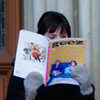When Will Braun attends Hope Mennonite Church in Winnipeg, he sits right at the back, where he feels most comfortable. Braun, a left-leaning activist, organic farmer, and editor of geez magazine — a quarterly launched in December 2005 — was raised in the southern Manitoba Bible Belt and felt frustrated with the insularity of the Church. “But at the same time there’s something there that I can’t let go of,” he says. He doesn’t make it to church every Sunday, but as he said on CBC Radio’s Tapestry, he tries “to go for the discipline, just to be present with other people and hang out.”
All three people at the core of geez — Braun, publisher and co-editor Aiden Enns, and art director Darryl Brown — were raised as observant Christians. Although they want the magazine “to carry an irreverent smirk,” geez’s editorial content belies their serious commitment to community, Jesus and social justice activism. According to Braun, its target audience is “people on the fringes of faith” — those who have either left the church entirely or are dissatisfied with the mainstream expression of Christianity and other religions.
Enns — a former reporter at Canadian Mennonite and former managing editor at Adbusters — decided to start the magazine because he saw “a whole community of social justice-oriented people whose words were not put down on paper, were not uttered. Journalists should be able to ask those questions, to articulate those unspoken words.” Despite geez’s in-your-face name, which was inspired by the New York-based Heeb: The New Jew Review, Enns isn’t just interested in making Christianity hip or simply attracting the many Christians who don’t attend church on a regular basis. Rather, he wants the magazine to build a community for itself within the already specialized world of Christian publications. With subscriptions steadily increasing — up from 500 to 2,000 over its first year — and newsstand sales of around 1,250 copies per issue, geez is accomplishing its goals of building community and offering a critical counterpoint to the religious right.
While the magazine is a fresh new take on independent Christian publications like Sojourners and the now-defunct Catholic New Times (CNT), its content places it on the fringe of mainstream journalism. Many of its stories are first-person essays written by non-journalists. Along with poetry, conceptual art and how-to pieces about greener living, the pages of geez seem more like those in Adbusters than a conventional magazine — especially considering the fact that geez doesn’t accept advertising (Braun says they “want to experiment with divorcing money and message”). It runs on a shoestring budget; last year, the core team of Enns, Braun and Brown awarded themselves honoraria of less than $5,000 total. In the cash-strapped climate of magazine publishing today, for geez to survive in its current incarnation will take a miracle.
• • •

On page 1 of the “Let’s get Evangelical” issue (Winter 2006) we meet the perfect family. Mom, Dad, teenage son and daughter — all pristinely turned out, all Barbie-like dolls — pose for a photograph, their smiles plastic. The son wears a sweater emblazoned with the Jesus fish symbol while the daughter proudly sports a peace symbol on her shirt. Cut to page 64, where the family is having a crisis: daughter sulks while Mom rips a political poster from her bedroom wall. The poster, depicting a scene of police brutality, proclaims “Terror Begins at Home” and clearly doesn’t fit with Mom’s beliefs. Dad looks stricken. Jennifer Williams, a Yukon-based freelance artist, created the carefully-crafted dioramas. She had a great experience working for geez, partly because the editors gave her the freedom to take an idea and run with it. “They gave me a lot of creative latitude,” she says. “It was a dream assignment.”
For the folks at geez, this kind of openness to experimentation and other perspectives is a core value in both the magazine’s content and their lives. In the same issue, a section called “Experiments” includes reader-submitted reflections on how to live more simply. This section is connected to the “De-motorize Your Soul” campaign launched by geez on the back cover of issue three. Braun, an avid cyclist who bikes on the Trans-Canada Highway, called for readers to give up motorized travel for one day a week and avoid airplanes for a year. Suggestions like, “Bike as though you were riding the road to heaven — human energy is the alternative energy,” certainly veer from the path of typical service journalism.
But geez also runs thought-provoking essays. The winter 2006 issue contains a reprinted Harper’s Magazinearticle by Bill McKibben, an environmentalist and author who argues that the U.S. is, among strongly self-professed Christian nations, the one that acts the least Christian. Other pieces include an analysis of the global evangelical movement and a series of short profiles of Christians and former Christians, probing their beliefs by asking what the religion means to them. They’re then rated, according to religious fervor, on an “Evangometer.”
• • •
CNT was just a few months shy of its 30th birthday when it closed its doors in November 2006 due to lack of funds. The bi-weekly, independent newspaper was started by a group of left-leaning Catholics who were disaffected with the narrow-minded coverage in the Catholic Register — the official organ of the church — and wanted an alternative voice that was committed to their social justice beliefs. From 2001 until its death, the editor of CNT was Ted Schmidt. “[The failure of the newspaper] didn’t make me sour,” he says. “It just made me think, �Wow, there are so many wonderful people doing the right things in society, and they’re not being fed by the institution as well as they should be.’ That’s my pain, that’s my sadness.”
The demise of the CNT was partly due to the fact that the younger generation of Catholics wasn’t subscribing. Rates fell steadily from around 12,500 in the early 1980s to about 4,000 in November 2006 (in an attempt to address this cultural trend, the CNT collective plans to re-launch the paper in an online format). Schmidt has doubts about whether print is a wise move for a niche magazine like geez that is aimed at younger readers. He thinks Braun, who once worked for him as a freelance writer, has the right idea, but needs to rethink his approach. “You are living in a capitalist society,” says Schmidt. “And you can’t survive without ads.”
John Longhurst, director of communications and marketing for the Canadian Mennonite University in Winnipeg, has written extensively about the role of the Church press. He agrees that the main challenge forgeez is financial, and tells the story of Canadian Mennonite, Enn’s former home. Originally called Mennonite Reporter, the publication started as an independent newspaper, but ultimately had to accept partial funding from Mennonite Church Canada to survive. “It has to adhere to the denominational line a little more,” explains Longhurst. “There is no watchdog that says, �Here’s what you can and can’t print,’ and nobody vets their articles, but they know that if they annoy too many people their funding will get cut off.”
Braun and Enns are well aware of how impractical it is to run an independent magazine without advertising. They struggle to find the resources to go forward and the staff to help them. Currently they aren’t eligible for many government grants because they don’t meet stipulations for Canadian content, though they recently hired a part-time circulation and office manager to help them get better organized. Braun underscores that their position on advertising is not based on moral judgement, but he does prefer the uncluttered look of an ad-free geez. He and Enns also want to spend their time working on editorial content rather than seeking out advertisers. On the phone from Winnipeg, he chuckles ironically, “We’ll see how that goes.”
Enns is thrilled with the number of Canadians that has signed on as subscribers and wants to expand his audience to the U.S. to counter the strong Christian right. He also wants to run more investigative pieces that expose the hypocrisy within the Christian business community.
But the main question surrounding geez remains: who’s going to pay for it? The magazine has many admirers who want to see it thrive despite a seemingly unsustainable formula, but will the support be enough? “We’ll have to see how long they can hold out,” says Longhurst, and then adds hopefully, “Aiden and Will are real simple-living guys. If anyone can do it, they can.”
About the author
Gena Smith was the Head of Research for the Spring 2007 issue of the Ryerson Review of Journalism.

